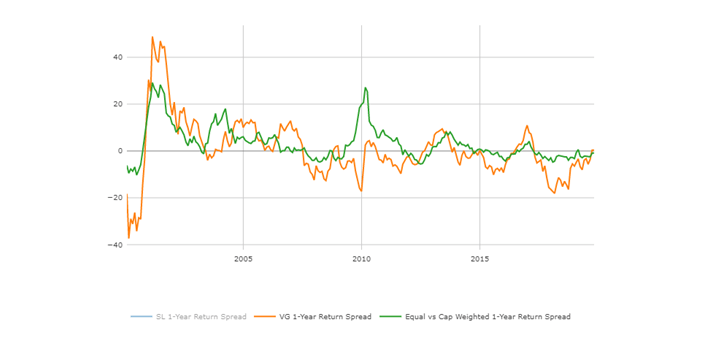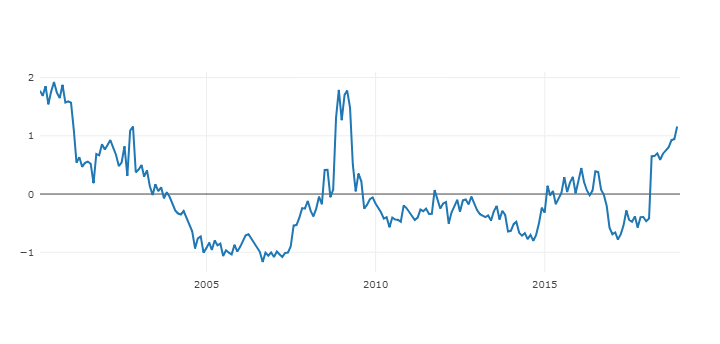
US economics, inflation, and the Fed
The Federal Reserve is not happy with the latest round of inflation data. Both consumer and producer (wholesale) prices exceeded expectations for March. Value Line highlights that, while price increase rates have come down significantly from their multiyear peak levels in 2022, getting to the Fed’s target of 2% is proving problematic now. The Fed’s favored inflation metric, the personal-consumption expenditures price index, showed inflation running at 2.7% in the 12 months through March, or 2.8% excluding volatile food and energy prices.
Overall, the latest data suggests that inflation may be reaccelerating, especially with commodity prices continuing to surge. The probability of an interest-rate reduction before the second half of this year plummeted on the inflation headlines. The price data brought more commentary from senior Fed officials that the lead bank should keep the federal funds rate high for longer to effectively fight inflation. Treasury yields jumped on this sentiment, with the rate on the 10-year Treasury note recently topping 4.7%, a level not seen since mid-November. Equity market volatility spiked on the possibility that a rate cut may be pushed farther out.
Professor Siegel notes:
“Fed funds futures suggest diminished rate hike expectations, hovering around a single cut this year. I believe we will get more than what’s currently priced in. The Personal Consumption Expenditure (PCE) Price Index deflator is on the horizon, and I anticipate it will not be high. We’re inching closer to the Fed’s target for inflation, and I expect a dip in inflation to a three-year low on the core PCE index this week. The narrative on the Consumer Price Index (CPI) should also improve, thanks to easing shelter costs and insurance premiums. With the Fed’s long-term neutral rate indicated at 2.6%, and current rates more than double that, there’s ample room for cuts. The real economic data showed retail sales as very strong, dispelling any notions of a slowdown which prompted upward gross domestic product (GDP) forecast revisions. Housing starts presented a rare dip in an otherwise steady data stream, including jobless claims maintaining a stable trend. Manufacturing reports hint at a resurgence, also suggesting underlying economic strength.”
Meanwhile, the US economy grew by 1.6% in the first quarter of 2024 — well below the expected 2.4%. Moreover, rising geopolitical tensions in the Middle East are troublesome. This included the first direct attack by Iran against Israel. This fighting threatens global supply chains, particularly in the energy complex. It may put upward pressure on commodities and ultimately the prices for a number of goods. Elevated commodity prices could threaten the current health of the U.S. economy, as resultant higher prices for essential items (i.e., food and energy) would probably force consumers to scale back spending on discretionary products according to Value Line.
Global economy
Consensus projections have been wrong multiple times in the last two years. While economists expected inflation and economic growth to slow down, current global readings are telling a different story. Global core CPI (ex. China and Türkiye) accelerated to a 3.6% annual rate last quarter, well exceeding JP Morgan’s forecast of a 3% annual rate at the start of the year. With the recent strong gain from China, 1st Quarter 2024 (1Q24) global GDP is on track to increase at a 3.2% annual rate or slightly below per the bank’s research.
While recent weeks have seen a shift in Fed rhetoric and a broad shift in market pricing of easing, disinflation remains embedded in forecasts presented by central banks, the latest IMF World Economic Outlook, and market expectations for inflation beyond the start of this year. JP Morgan’s bottom-up forecasts also see 1Q24 surprises as a “bump in the road.” Expectations of a moderation in global GDP growth to a below-trend pace alongside gradual disinflation have not been altered by last quarter’s surprises.
Nevertheless, JP Morgan sees encouraging signs that the global expansion is forming a broader base as we move through the first half of 2024. The bank’s Capexnow tracker points to a pickup in equipment spending last quarter with momentum building further in March-April. Aligned with still strong global employment gains, the business sector appears to remain in expansion mode. A positive signal is also coming from consumers. Following a dip at the start of the year JP Morgan’s retail sales tracker looks to be rising alongside a step up in consumer confidence. The bank’s forecast has anticipated a lift in European and Japanese consumption this year in response to rising real labor income. Moreover, the most recent retail sales report shows that the US consumer is more resilient to rising gasoline prices. With a dip in the household saving rate to 3.6% expected to lift 1Q24 consumption to a 3.3% annual rate increase, a strong case can be made that the wealth effect is coming back to life after fading in the wake of the global financial crisis.
Stronger growth is not by itself an obstacle for easing. Developed markets growth has generally been weak outside the US and JP Morgan anticipates central banks in Western Europe, Canada, and New Zealand will begin easing in the coming months amidst a modest growth acceleration. The equation is different for the Fed. A cautious Fed can still ease later this year if inflation news moves back in line with its forecast. With most central banks ready to become more accommodative for economic growth, JP Morgan sees the world economy advancing by a 2.6% real growth rate in 2024.
Stock market
The stock market had a stellar beginning of the year in the 1stQ 2024. While earlier in the year the Magnificent Seven (Tech Mega Caps) drove positive returns for markets, we are encouraged by broader participation supporting markets recently. As you can see below, the Equal vs Cap Weighted Spread (1Y) started turning towards the equally weighted index domination in March of 2024. That is a very good sign for sustainability of market advances going forward.
Equal vs. Market Cap Weighted Return Spread 1 Year:

BlackRock in their Student of the Market April 2024 publication reinforces the observation cited above by showing historic market returns following strong momentum early in the year.

So, while we don’t have a crystal ball, the probability of positive returns this year is pretty high. Keep the Faith!
The information and opinions included in this document are for background purposes only, are not intended to be full or complete, and should not be viewed as an indication of future results. The information sources used in this letter are: WSJ.com, Jeremy Siegel, Ph.D. (Jeremysiegel.com), Goldman Sachs, J.P. Morgan, Empirical Research Partners, Value Line, BlackRock, Ned Davis Research, First Trust, Citi research, HSBC, and Nuveen.
IMPORTANT DISCLOSURE
Past performance may not be indicative of future results.
Different types of investments and investment strategies involve varying degrees of risk, and there can be no assurance that their future performance will be profitable, equal to any corresponding indicated historical performance level(s), be suitable for your portfolio or individual situation, or prove successful.
The statements made in this newsletter are, to the best of our ability and knowledge, accurate as of the date they were originally made. But due to various factors, including changing market conditions and/or applicable laws, the content may in the future no longer be reflective of current opinions or positions.
Any forward-looking statements, information, and opinions including descriptions of anticipated market changes and expectations of future activity contained in this newsletter are based upon reasonable estimates and assumptions. However, they are inherently uncertain, and actual events or results may differ materially from those reflected in the newsletter.
Nothing in this newsletter serves as the receipt of, or as a substitute for, personalized investment advice. Please remember to contact Signet Financial Management, LLC, if there are any changes in your personal or financial situation or investment objectives for the purpose of reviewing our previous recommendations and/or services. No portion of the newsletter content should be construed as legal, tax, or accounting advice.
A copy of Signet Financial Management, LLC’s current written disclosure statements discussing our advisory services, fees, investment advisory personnel, and operations are available upon request.



























































































